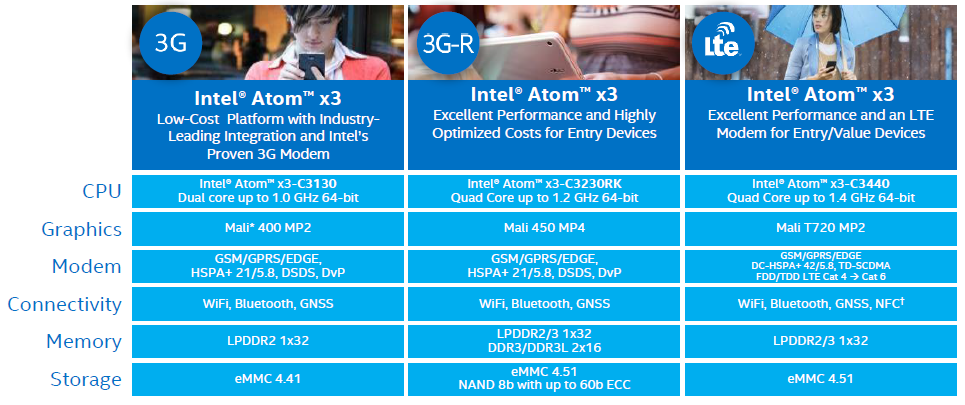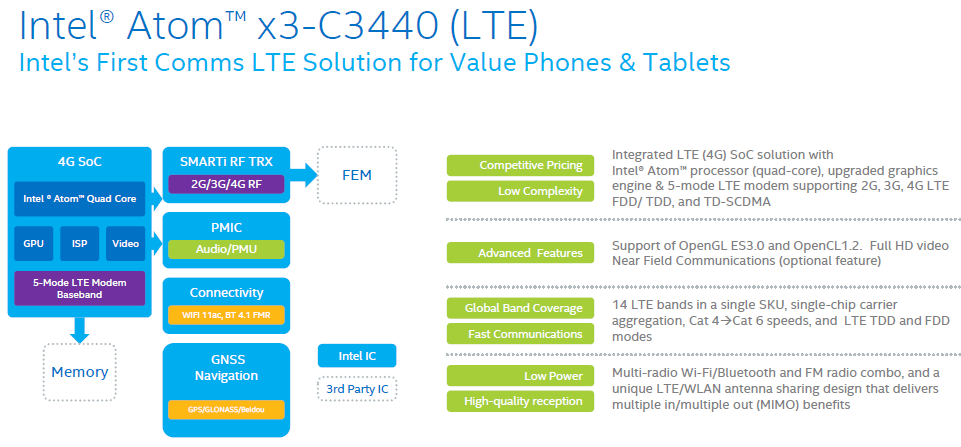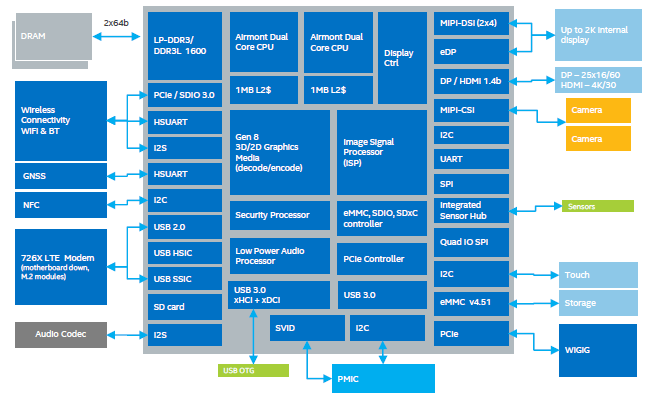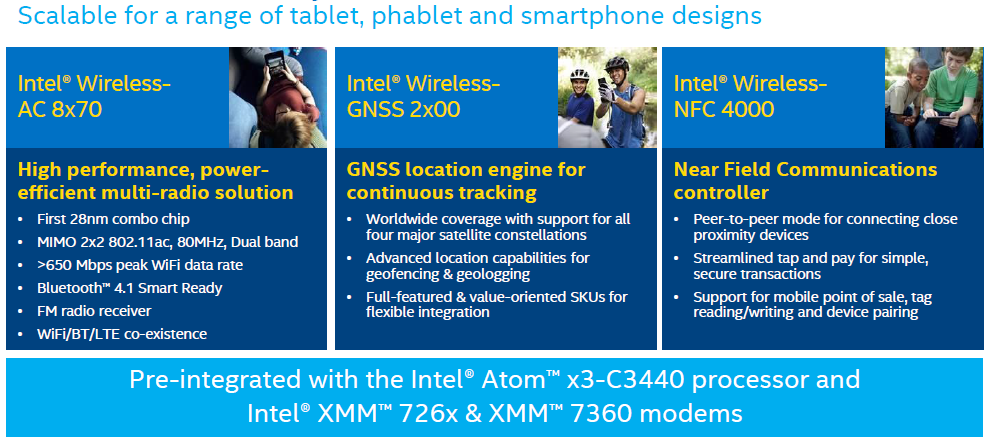Intel Outs Cherry Trail Atom x5 And x7 SoCs; Entry-Level SoFIA Chips, Too
At Mobile World Congress today, Intel announced its new spate of mobile chips, which includes Cherry Trail as well as the entry-level SoFIA series.
Taken together, Intel has a rather tall mobile processor stack that runs from low-end chips up to just short of Core M. (Indeed, Core M is not at the bottom of Intel's laptop chip stack; it's at the top of Intel's mobile chip stack.)
Intel Atom x3 (SoFIA)
At the lower end of the pool is the Intel Atom x3 series of processors, the SoFIA series; the next step Intel Atom x5 (Wi-Fi only); and above that is the Intel Atom x5 and x7 chips.
Atom x3 (SoFIA) is aimed at the entry level/value market but is 64-bit enabled, offers 3G or 4G LTE connectivity (depending on the chip), and will have 13 MP front and 5 MP rear cameras. Wi-Fi, Bluetooth, NFC and GNSS are part of the package. The chips will support both Android and Windows.
There are three Atom x3 chips: 3G (Intel Atom x3-C3130), 3G-R (Intel Atom x3-C323RK) and LTE (Intel Atom x3-C3440). You can see the chip breakdowns below:
Intel said that the SoFIA 3G-R's media performance should be able to beat out similar offerings from Qualcomm and MediaTek by 1.8x, and the SoFIA LTE should deliver a 2x media editing performance.
Really, Atom x3-powered devices will be international, aimed largely at emerging markets. (The partner list includes primarily international OEMs, such as Weibu, Quanta, Jolla, Pegatron and Compal.) We believe that Windows 10 on mobile will run on these devices, as well as Android.
Get Tom's Hardware's best news and in-depth reviews, straight to your inbox.
Prices promise to be low; at the 3G level, expect prices below $75, while the 3G-R and LTE versions will hover around price points from $150-$249.
Cherry Trail: Intel Atom x5 And x7
The successor to Bay Trail, the new Cherry Trail SoCs are Intel's first Atom chip built on the 14nm process. They're designed to power next-gen tablets, from 7-inch tablets to 10.1-inch 2-in-1s. The Atom x5 (Z8500 and Z8300 series) will hit mainstream devices, while the x7 (Z8700 series) is aimed at higher performance, with prices ranging from $119-$499.
All are 64-bit CPUs with Intel Gen 8 graphics. Graphics appear, in fact, to have been a major focus for Intel in the development of these chips. The company told us that the new Atom x7 will best the previous-gen Atom Z3795 by a factor of two in GFXBench 2.7 and will see a 50 percent performance boost in 3DMark Ice Storm Unlimited. Expect better performance in any OpenGL or DirectX tasks.
Intel put in some attractive user experience bits in the new SoCs, including its RealSense technology. Look for both the RealSense Snapshot (R100) rear-facing camera and the RealSense 3D (R200) camera in upcoming Cherry Trail-powered SKUs. The former offers powerful post-photo editing capabilities and some measurement tools; the latter adds 3D depth imaging, too. Intel Pro WiDi is on board, and it's designed to offer cable-less meeting rooms and home offices. For security, Intel added in True Key, which includes multifactor authentication.
Some Atom x5 chips will be Wi-Fi only, while the rest of the X5 line and the x7 series will have discrete modems. Actually, Intel took this time to announce its 3rd-generation LTE modem, the Intel XMM 7360. Its 5-mode LTE supports up to 29 LTE bands globally, and it offers LTE Broadcast, Voice over LTE (VoLTE), dual-SIM capabilities, and dual and single receiver options.
Intel promised up to 450 Mbps downlink performance and told us to expect commercial devices with the modem coming 2H 2015.
In addition, Intel announced more wireless connectivity products:
Intel is making a play here for a bigger chunk of the mobile market. Taking aim at both midrange and entry-level devices, many of which will be from OEMs in emerging markets, may not be particularly sexy, but it is sensible. We will look forward to putting the new chips through the paces as soon as we get the chance.
Follow us @tomshardware, on Facebook and on Google+.
Seth Colaner previously served as News Director at Tom's Hardware. He covered technology news, focusing on keyboards, virtual reality, and wearables.
-
RedJaron I've been using an Acer Switch 10 for a few months and have been generally pleased with it. Would love to see what kind of 2-in-1 these chips will be found in. A 10" Win8/10 2-in-1 with built-in LTE for under $400 would make me consider an upgrade.Reply -
hannibal Most interesting processors to new Wintel tablets! Increased GPU speed is promising for light gaming with windows tablets and 14nm process should provide even better battery usage.Reply
Just hope to see one of these in good 9 to 10 " tablet with reasonable resolution IPS screen. 1080p minimum. -
digitaldoc Will have to see what products these chips end up in, at what price points. They have potential though.Reply -
rluker5 wintel probably won't but they could do the whole windows pc on a phone thing with one of these if they put a micro hdmi port on it. the keyboard/mouse/gamepad would be Bluetooth. I've got that on a lesser baytrail and it's a better htpc than an average vista desktop. it would be nice for boring slideshows over the holidaysReply -
epobirs hixbot , March 2, 2015 11:57 AMReply
It may be finally time to break my Cherry Trail.
-----------
A double! Most impressive, sir. -
aldaia Unfortunately for Intel, the mobile market doesn't care about x86, no matter how great their processors are. Those processors may take a share in the tablet market, but tablets are as saturated as desktops, it's not anymore a growing market. A lot of people are replacing their old tablet + their old smartphone by a newer phablet. The growth potential and the high volume is still in the smartphone camp, where the big names are Apple, Samsung, Qualcomm and MediatekReply -
MyDocuments Hmm, it remains to be seen how seriously an x86 Android Phone can be taken, given that there are still application incompatibility issues despite the marketing given by Intel in order to allay these fears.Reply
Comparative battery life would also be a good measure of these CPU's without taking into account how much faster these CPUs can get the job done... days (or even better weeks) between charging would be a good measure.
Also interesting is the use of ARM-based MALI Gfx options, which means the licensing fees associated with the move to an x86 core are still not behind Intel. I guess the modem may also still contain a core or more from ARM. -
MyDocuments PS It's anyway a good thing to see more competition in any market. Hopefully this raises the technology and lowers the prices from everyone who chooses to compete.Reply -
RedJaron Reply
Where are you getting that mobile consumers don't want x86? The very notion of an x86 phone is drool inducing to most people in my department. The majority of the public is likely indifferent to x86 in that they don't care what architecture so long as it runs well.15408104 said:Unfortunately for Intel, the mobile market doesn't care about x86, no matter how great their processors are. Those processors may take a share in the tablet market, but tablets are as saturated as desktops, it's not anymore a growing market. A lot of people are replacing their old tablet + their old smartphone by a newer phablet. The growth potential and the high volume is still in the smartphone camp, where the big names are Apple, Samsung, Qualcomm and Mediatek
And yes, a lot of people are replacing their old tablets. So which would you prefer: another iPad that's 0.01% thinner and 0.02% faster, or a full x86 tablet or 2-in-1 with LTE connectivity that's only a mobile keyboard and mouse away from being a desktop in a pinch? Hell, there's no reason an x86 phone couldn't act like a Windows thin client.




